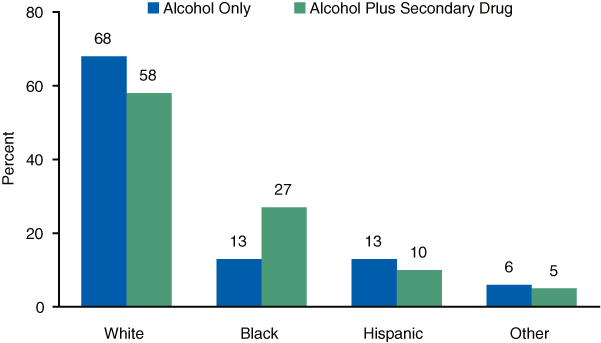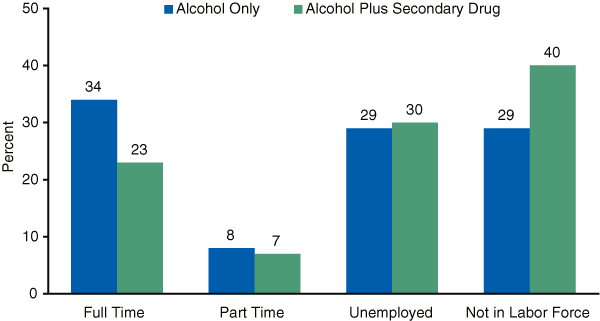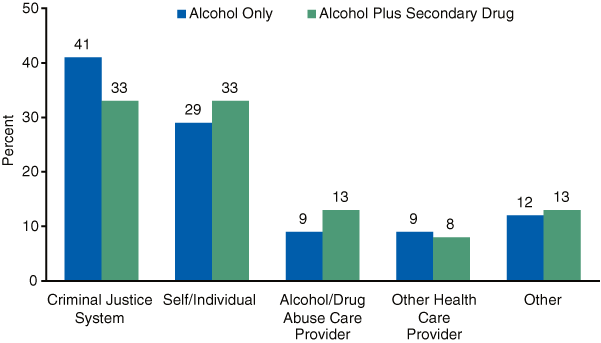
 |
February 2, 2007 |
|
The National Survey on Drug Use and Health found that about 18.7 million Americans were dependent on or abused alcohol in 2005. Of these, 3.3 million were dependent on or abused an illicit drug.1 Some of these people enter treatment, and their admissions can be monitored with the Treatment Episode Data Set (TEDS), an annual compilation of data on the 1.8 million annual admissions to substance abuse treatment facilities, primarily those that receive some public funding. TEDS records represent admissions rather than individuals, as a person may be admitted to treatment more than once during a single year.
In 2005, over one third of all TEDS admissions (36 percent) were both aged 21 or older and reported alcohol as the primary substance of abuse.2 This report examines these admissions, comparing about 374,000 admissions (56 percent) where alcohol was the only substance of abuse (alcohol only) with about 289,000 admissions (44 percent) that reported alcohol plus a secondary drug.3
In terms of gender, admissions aged 21 or older for alcohol only and alcohol plus a secondary drug in 2005 were similar; about three fourths of the admissions in each group were male (75 and 74 percent, respectively).
In 2005, admissions aged 21 or older for alcohol only were older at admission than admissions for alcohol plus a secondary drug. The average age at admission for alcohol only was 41 years, while the average age at admission for alcohol plus a secondary drug was 37 years. Admissions for alcohol only were also older at first intoxication than admissions for alcohol plus a secondary drug. The average age of first intoxication among admissions for alcohol only was 18 years; for admissions for alcohol plus a secondary drug the average age of first intoxication was 16 years.4
Admissions aged 21 or older in 2005 that were for alcohol only were more likely than admissions for alcohol plus a secondary drug to be White (68 vs. 58 percent) (Figure 1). More than one quarter (27 percent) of admissions for alcohol plus a secondary drug were Black, while only 13 percent of admissions for alcohol only were Black.
 |
Source: 2005 SAMHSA Treatment Episode Data Set (TEDS). |
| Race/Ethnicity | Alcohol Only | Alcohol Plus Secondary Drug |
|---|---|---|
| White | 68% | 58% |
| Black | 13% | 27% |
| Hispanic | 13% | 10% |
| Other | 6% | 5% |
Source: 2005 SAMHSA Treatment Episode Data Set (TEDS). |
In 2005, alcohol-only admissions aged 21 or older were more likely than admissions for alcohol plus a secondary drug to be employed full time (34 vs. 23 percent) and less likely to be not in the labor force (29 vs. 40 percent) (Figure 2).5
While the most common marital status for all primary alcohol admissions 21 years of age or older in 2005 was “never married,”6 alcohol-only admissions were less likely than admissions for alcohol plus a secondary drug to have been never married (43 vs. 52 percent). Furthermore, alcohol-only admissions were more likely than admissions for alcohol plus a secondary drug to be either currently married (23 vs. 17 percent), or separated, divorced, or widowed (34 vs. 31 percent).
 |
Source: 2005 SAMHSA Treatment Episode Data Set (TEDS). |
| Employment Status | Alcohol Only | Alcohol Plus Secondary Drug |
|---|---|---|
| Full Time | 34% | 23% |
| Part Time | 8% | 7% |
| Unemployed | 29% | 30% |
| Not in Labor Force | 29% | 40% |
Source: 2005 SAMHSA Treatment Episode Data Set (TEDS). |
In 2005, the most common principal sources of referral among admissions aged 21 or older for both alcohol only and alcohol plus a secondary drug were self/individual referrals and the criminal justice system (Figure 3). Admissions for alcohol only, however, had a higher proportion of criminal justice system referrals than admissions for alcohol plus a secondary drug (41 vs. 33 percent).
 |
Source: 2005 SAMHSA Treatment Episode Data Set (TEDS). |
| Source of Referral | Alcohol Only | Alcohol Plus Secondary Drug |
|---|---|---|
| Criminal Justice System | 41% | 33% |
| Self/Individual | 29% | 33% |
| Alcohol/Drug Abuse Care Provider | 9% | 13% |
| Other Health Care Provider | 9% | 8% |
| Other | 12% | 13% |
Source: 2005 SAMHSA Treatment Episode Data Set (TEDS). |
Service settings are of three types: ambulatory, residential/rehabilitative, and detoxification.7 In 2005, more than half of admissions aged 21 or older for both alcohol only and alcohol plus a secondary drug were admitted to ambulatory service settings (56 percent each). Admissions for alcohol only were more likely than admissions for alcohol plus a secondary drug to be admitted to detoxification services (33 vs. 25 percent) and less likely to enter residential/rehabilitative services (11 vs. 19 percent).
Admissions aged 21 or older in 2005 for alcohol plus a secondary drug were more likely than alcohol-only admissions to have an extensive treatment history. Among admissions aged 21 or older, those admitted for alcohol only were more likely than those admitted for alcohol plus a secondary drug to be first-time admissions (50 vs. 39 percent) and less likely to have one to four prior admissions (41 vs. 49 percent) or five or more prior admissions (9 vs. 12 percent).
In 2005, alcohol-only admissions aged 21 or older were about as likely as those for alcohol plus a secondary drug to have not used alcohol at all in the past month (25 vs. 26 percent). Alcohol-only admissions aged 21 or older were less likely than those for alcohol plus a secondary drug to have used alcohol daily (36 vs. 42 percent), and more likely to have used alcohol less than daily in the past month (39 vs. 32 percent).
1 Substance Abuse and Mental Health Services Administration, Office of Applied Studies. (2006). Results from the 2005 National Survey on Drug Use and Health: National findings (NSDUH Series H-30, DHHS Publication No. SMA 06-4194). Rockville, MD, table G.29.
2 The primary substance of abuse is the main substance reported at the time of admission. Secondary/tertiary substances are other substances of abuse also reported at the time of admission.
3 For information from an earlier report, see: Substance Abuse and Mental Health Services Administration, Office of Applied Studies. (November 25, 2005). The DASIS report: Primary alcohol admissions aged 21 or older: Alcohol only vs. alcohol plus a secondary drug: 2003. Rockville, MD.
4 Age of first use is defined differently for alcohol than for drugs. For alcohol, age of first use signifies age of first intoxication. For drugs, age of first use identifies the age at which the respective drug was first used.
5 Not in the labor force includes those not looking for work during the past 30 days, students, homemakers, disabled or retired persons, or inmates of an institution.
6 Marital status is a Supplemental Data Set item. The 41 States and jurisdictions in which it was reported for at least 75 percent of admissions in 2005—AL, AR, CO, CT, DE, FL, GA, HI, IA, ID, IL, IN, KS, KY, LA, MA, MD, ME, MI, MN, MO, MS, NC, ND, NE, NH, NJ, NV, OH, OK, OR, PA, PR, RI, SC, SD, TN, TX, UT, WA, and WV—accounted for 67 percent of all substance abuse treatment admissions in 2005.
7 Ambulatory settings include intensive outpatient,
non-intensive outpatient, and ambulatory detoxification. Residential/rehabilitative
settings include hospital (other than detoxification), short-term (30 days or
fewer), and long-term (more than 30 days). Detoxification includes 24-hour hospital
inpatient and 24-hour free-standing residential.
8 Psychiatric problem in addition to alcohol or drug problem is a Supplemental Data Set item. The 26 States and jurisdictions in which it was reported for at least 75 percent of all admissions in 2005—AR, CA, CO, DE, FL, IA, ID, KS, KY, LA, MA, MD, ME, MI, MO, MS, NC, NV, OH, OK, PR, RI, SC, TN, UT, and WV—accounted for 45 percent of all substance abuse treatment admissions in 2005.
| The Drug and
Alcohol Services Information System (DASIS) is an integrated data
system maintained by the Office of Applied Studies, Substance Abuse and
Mental Health Services Administration (SAMHSA). One component of DASIS
is the Treatment Episode Data Set (TEDS). TEDS is a compilation of data
on the demographic characteristics and substance abuse problems of
those admitted for substance abuse treatment. The information comes
primarily from facilities that receive some public funding. Information
on treatment admissions is routinely collected by State administrative
systems and then submitted to SAMHSA in a standard format. TEDS records
represent admissions rather than individuals, as a person may be
admitted to treatment more than once. State admission data are reported
to TEDS by the Single State Agencies (SSAs) for substance abuse
treatment. There are significant differences among State data
collection systems. Sources of State variation include completeness of
reporting, facilities reporting TEDS data, clients included, and
treatment resources available. See the annual TEDS reports for details.
Approximately 1.9 million records are included in TEDS each year. The DASIS Report is prepared by the Office of Applied Studies, SAMHSA; Synectics for Management Decisions, Inc., Arlington, Virginia; and by RTI International in Research Triangle Park, North Carolina (RTI International is a trade name of Research Triangle Institute). Information and data for this issue are based on data reported to TEDS through February 1, 2006. Access the latest TEDS reports
at: |
| The DASIS Report is published periodically by the Office of Applied Studies, Substance Abuse and Mental Health Services Administration (SAMHSA). All material appearing in this report is in the public domain and may be reproduced or copied without permission from SAMHSA. Additional copies of this report or other reports from the Office of Applied Studies are available on-line: http://www.oas.samhsa.gov. Citation of the source is appreciated. For questions about this report please e-mail: shortreports@samhsa.hhs.gov |
|
This page was last updated on December 30, 2008. |
|
SAMHSA, an agency in the Department of Health and Human Services, is the Federal Government's lead agency for improving the quality and availability of substance abuse prevention, addiction treatment, and mental health services in the United States. 
* PDF formatted files require that Adobe Acrobat Reader® program is installed on your computer. Click here to download this FREE software now from Adobe. |